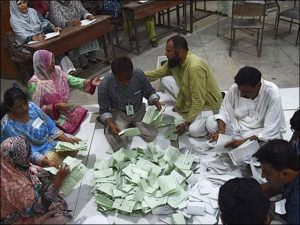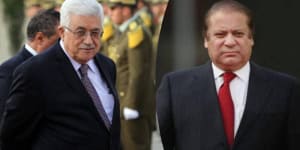Finance Minister Ishaq Dar on Friday unveiled the annual federal budget in the National Assembly for the next fiscal year. It was the fifth consecutive budget presented by Ishaq Dar.
Following is the full budget brief for Parliamentarians delivered by Federal Finance Minister Ishaq Dar in the National Assembly on Friday:
For the first time in the history of Pakistan, the same elected Prime Minister and Finance Minister are presenting the national budget for the fifth consecutive year. This reflects strengthening of democratic tradition, continuity of economic policies witnessed in the prevailing fiscal stability in the country.
When we look back in 2013, economy was on the verge of collapse, foreign exchange reserves were alarmingly low, fiscal deficit was at an unsustainably high level of over 8% of GDP and the country was facing 10-14 hours of load shedding every day. Deterioration in the security and law and order situation was a major constraint to economic and business activity in the country.
In the last four years, we have been able to achieve a wholesome turnaround. This achievement has been recognized by credible global institutions. The economy has firmly been set on a high growth trajectory which is being acknowledged by the international financial institutions. Credit rating agencies have also improved Pakistan’s short and long term credit ratings. Most recently, Price Waterhouse Coopers has predicted that “Pakistan’s economy is set to be among the 20 largest economies (G20) of the World by 2030.”
Economic Performance (2016-17 vs. 2012-13)
GDP Growth has registered an increase of 5.28% compared to 3.7%. This is the highest in the last ten years and above the world average of 3.5%.
Federal development spending is budgeted at Rs. 1,001 billion – an increase of over three times from Rs. 324 billion.
Per Capita Income has increased to $1,629 from $1,334, showing that economic growth has picked up pace considerably.
Inflation has remained moderate around 4% as compared to 7.4%.
FBR Revenues have increased to Rs.3,520 billion from Rs.1,946 billion, representing an increase of 81% in last four years.
Fiscal deficit has declined to mid 4% of GDP from a high of over 8%.
Remittances for the first ten months of the current fiscal year (Jul-Apr) stand at $15.6 billion, compared to $ 11.57 billion in the same period of 2012-13. They are expected to further increase in the last two months due to Ramzan and Eid.
Exchange Rate, which had depreciated to Rs.109/$ in December 2013 has now stabilized at Rs.105/$.
Foreign Exchange Reserves with SBP have jumped to over $16 billion from $6 billion in June 2013.
The merger of three stock exchanges into Pakistan Stock Exchange was completed in January 2016. It has shown exceptional performance, from 19,916 points on 10th May 2013 to over 52,000 points currently after merger. It has been moved to the emerging markets by Goldman Sachs Capital Index and declared as Asia’s best performing by Bloomberg.
Salient features of the budget 2017-18.
• The total revenue is estimated at Rs.5,310. This includes FBR tax estimate of Rs.4,013 billion as compared to revised estimate of Rs.3,521 billion. As compared to revised estimates of FY 2016-17 the total revenue is being increased by 12%. While the FBR tax revenue is estimated to increase by 14%;
• Out of the total revenues, the provincial governments share is estimated to be Rs.2,384 billion as compared to Rs.2,121 billion revised estimates for 2016-17, showing an increase of about around 12.4%. These resources will be utilized by the provincial governments in enhancing human development and security of the people.;
• After transfer to provincial governments, the net revenue of the Federal Government is estimated at Rs.2,926 billion in 2017-18 as compared to revised estimates of Rs.2,616 billion in the current financial year.
• Total expenditure for FY 2017-18, is budgeted at Rs.4,753 billion compared to the revised estimates of Rs.4,256 billion for 2016-17, showing an increase of 11.7%. Out of the total expenditure highest increase is accorded to the development budget.
• The defence budget is proposed at Rs.920 billion against the revised budget of Rs.841 billion in the FY 2016-17;
• As I had said earlier, the PSDP budget is being increased from revised estimates of Rs.715 billion to Rs.1,001 showing a 40% increase;
• The result of the above revenue and expenditure estimates is that the budget deficit will be reduced to 4.1% of GDP as opposed to 4.2% of GDP of revised budget estimate in the financial year in 2016-17.
Budget Targets 2017-18
The following goals & targets have been set for FY 2017-18:
• Real GDP Growth of 6%
• Investment to GDP ratio of 17%
• Inflation below 6%
• Budget deficit at 4.1% of the GDP
• Tax to GDP ratio at 13.7%
• Development expenditure of Rs. 2.1 trillion
• Foreign Exchange Reserves level to cover a minimum of 4 months’ imports
• Net Public Debt to GDP ratio below 60%
• Elimination of load shedding by addition of 10,000 MW of electricity to the National Grid by Summer 2018.
• Continuation of targeted social interventions
Budget Strategy 2017-18
The above targets will be achieved through the following strategy:
• FBR revenue targeted to increase by 14% while Federal expenditure will grow by 11%.
• Federal PSDP for next year budgeted at Rs.1,001 Billion which is 40% higher than revised estimate of Rs.715 billion for the current Fiscal Year. With the addition of provincial ADPs the total development outlay for FY 2017-18 would be Rs.2.1 trillion.
• Growth in current (non-development) expenditure will be contained below the level of inflation.
• New initiatives being announced for Agriculture, Financial Sector, Exports, Textiles, Social Sector and Employment generation.
• Tax incentives are being announced to facilitate Agriculture, IT and Services sectors.
• Investments to speed up process of Development of Gwadar including establishment of Airport, Hospital and Desalination plant.
Special Initiatives
• BISP Beneficiary Graduation Program Grants – to self-sustain individuals: BISP beneficiary families starting their own business will be provided training as well as a one-time cash grant of Rs. 50,000. Initially, 250,000 families will be targeted with a size of Rs. 12.5 billion
• Increase in BISP allocation: Around 5.5 Million mostly women led families will be provided with Cash transfer of Rs.19,338 Per Annum, for which Rs.121 Billion will be allocated to Benazir Income Support Program (BISP). This allocation is an increase of 300% of the Rs.40 Billion allocated in FY 2012-13.
• Off-grid electricity solutions in small cities: In areas with no transmission lines, the Government in partnership with World Bank will introduce solar power systems for small towns and cities with sparsely populated areas with special focus on Balochistan.
• Agriculture:
In order to give further boost to the Prime Minister’s Kissan Package of 2015 following additional measures being introduced:
. Reduced mark-up rates: small farmers with 12.5 acres landholding to be provided loans at reduced mark-up of 9.9% per annum from current range of 10-14%.
. Enhancement in the target of agriculture credit to Rs.1,001 Billion from last year’s target of Rs. 700 billion, which is an increase of 43%.
. Maintaining concessional fertilizer prices: subsidy impact of Rs. 13.8 billion on DAP and nitrogenous fertilizers by fixing sales tax rates at Rs. 100 per bag.
. Use of automated land revenue records for agricultural credit to facilitate farmers.
. Establishment of Plants Breeders Rights Registry (PBRR) to register new high quality seeds which will increase crop yields.
. Continuation of subsidized electricity tariff for agri tube-wells @ Rs. 5.35 per unit with estimated cost of Rs. 27 billion.
. Production Index Units to be increased from 4,000 to 5,000 to faciltitate farmers to get maximum credit from banks.
Agricultural tax incentives
. Reduction in customs duty and sales tax at import stage to 0% for new and upto 5 year old Combined Harvesters.
. Removal of GST on imported Sunflower and Canola Hybrid seeds.
. Reduction of GST @ 7% on imported machinery for poultry and livestock.
. Reduction in Sales tax from 17% to 10% to encourage use of Peter engine.
• Export Promotion & Textiles:
All measures announced in FY 2016-17 will be continued in FY 2017-18. Following additional measures are proposed for the textile sector:
. Zero-rated sales tax regime for 5 export oriented sectors: textile, leather, sports goods, surgical goods and carpets announced in FY 2016-17 will continue.
. Similarly Duty-free import of textile machinery to continue.
. Rs.5 Billion allocated for implementation of various schemes under Textile Policy.
. A system of Cotton hedge trading for domestic cotton will be initiated to stabilize cotton prices.
. Brand Development Fund for Textile Sector to be launched.
. Implementation of the establishment of 1,000 stitching units to be started during FY 2017-18 and will be completed in 3 years.
. Ministry of Textile industry to launch first ever online textile business/ trade portal for textiles using B2B and B2C mode.
. The government has established an Export-Import Bank (EXIM), tol be operationalized next year
. Mark-up rates of Export Refinance Facility reduced from 9.5% in June 2013 to 3% in July 2016
. Custom duty on raw-hides and skins will be reduced to zero
. Stamping foil used in producing high value added finished leather will also be exempted from customs duty
. Allow warehousing of rice outside Pakistan to rice exporters.
• Housing:
. Risk Sharing Guarantee Scheme for low-income housing will be launched. Under this scheme, the Government will provide 40 percent credit guarantee cover to Banks and DFIs for home financing for up to Rs.1 million.
. In addition to financing for public sector infrastructure the government is also facilitating private sector investment and finance in infrastructure.
. Pakistan Development Fund (PDF) long-term infrastructure financing for commercially viable public sector and PPP projects
. Pakistan Infrastructure Bank (PIB) will also be established to provide infrastructure financing for commercially viable private sector projects.
. Public Private Partnership Bill provides a regulatory framework for promotion of financing public-private-partnership projects in the country
• Financial Inclusion:
. The government is implementing the National Financial Inclusion Strategy. For the next year, the following initiatives are being proposed
. Rs.8 billion fund to be created at the State Bank of Pakistan to provide loans to low-income segments
. To facilitate transactions through mobile banking, the Government is establishing a state-of-the-art e-gateway system at the State Bank of Pakistan at a cost of Rs.200 million.
. Exemption from withholding tax on cash withdrawal by branchless banking agents to the extent of actual disbursement to clients
. Establishment of Pakistan Microfinance Investment Company (PMIC) to augment availability of capital for microfinance institutions.
. An Endowment Fund of Rs.12.58 billion has been created for disaster risk management
. Small and Medium Enterprises (SMEs)
. The Government is planning to introduce Risk Mitigation Facility for Small and Medium Enterprises through a Rs.3.5 billion fund
. The Government is announcing establishment of an Innovation Challenge Fund with Rs.500 million
. Secure Transaction registry for Movable Property, which will enable small borrowers in SME and agriculture sector to obtain loans by pledging their moveable property
• Information Technology:
. Government will set up an IT software park in Islamabad with the help of Korean Government at a cost of 6 billion rupees.
. Income Tax Exemption for the first 3 years for start-up software houses
. Exports of IT services from Islamabad and other Federal territories shall be exempted from Sales Tax
. IT export houses/companies shall be allowed to open Foreign Exchange Accounts in Pakistan
. Reduction in withholding income tax on cell phone call from 14% to 12.5% and Federal Excise Duty from 18.5% to 17%
. Custom duty on Smart/Android phones shall be reduced from Rs.1,000 to Rs.650.
Relief Measures
Welfare Scheme for families of Shuhada (Martyrs): Under this scheme, a guaranteed and enhanced profit will be given to the families of Shuhada on CDNS instruments
Scheme for disabled persons: the provision of 2% employment quota to be extended to public and publically listed companies
Pakistan Bait Al Mal. Budget increased from Rs.4 Billion to Rs.6 Billion which will be utilised for financial assistance to individuals, child support Programme, orphanages through Pakistan Sweet Homes and Thalassemia Centre for treatment of poor children
Loan write-off for widows scheme: loan obligations of widows falling under House Building Finance Corporation will be written-off. This scheme is being re-launched with enhancement in loan write-off limit from Rs. 350,000 to Rs. 500,000.
Facilitating pensioners, widows and elderly of CDNS: CDNS has become member of banking clearing house resulting in reduced transaction clearance time by 5 days, online branch presence offering 24/7 customer care center, debit cards, mobile and net banking solutions.
Facilitating the expatriates: Government plans to invite the Pakistani diaspora to invest in infrastructure development of the country and will issue a sovereign non-convertible Bond specifically with a rupee coupon.
To further facilitate investment by the Pakistan diaspora in the real estate sector, CDA shall announce an exclusive sector for ex-pat Pakistanis
Subsidy on electricity usage: The government will continue to subsidize bills of low income domestic electricity consumers upto 300 units per month in shape of electricity subsidies. For farmers in Balochistan, Government will pay portion of their electricity bills, while billing for agriculture tube-wells will continue at significantly reduced rates. For this purpose Rs.121 Billion have been allocated.
The Prime Minister’s Youth Schemes, which include business loans scheme, interest free loans scheme, training scheme, skill development program, fee reimbursement for students of backward areas, laptop program and health insurance programs will continue. For this Rs.20 Billion have been allocated in FY 2017-18
Relief measures for Government Employees and pensioners
Increase in different allowances admissible to personnel of Armed forces and civil pensioners.
Employees in BPS-3 exempted from deduction of house-rent charges at the rate of 5%;
Daily Allowance – domestic – for BS 1-18 increased by 50% and for BS 19 and above at the rate of 75%.
Minimum Wage:
The minimum wage of labour increased from Rs.14,000 to Rs.15,000 per month
PSDP 2017-18
The majority of the Rs. 1,001 billion Federal PSDP has been allocated for roads and communications, infrastructure and energy. Infrastructure has been allocated 67% of the development outlay. The transport and communication sector has been allocated Rs. 411 billion, including Rs. 320 billion for national highways, Rs. 43 billion for railways and Rs. 44 billion for other projects including aviation schemes.
















